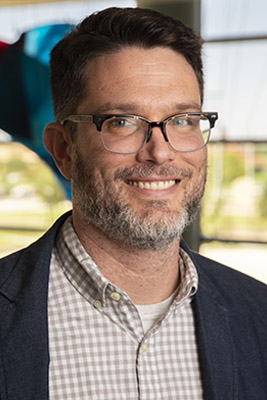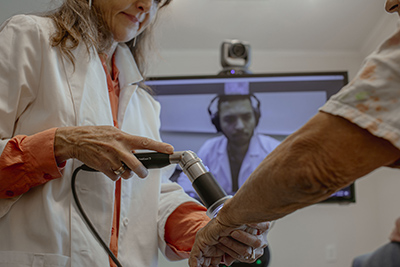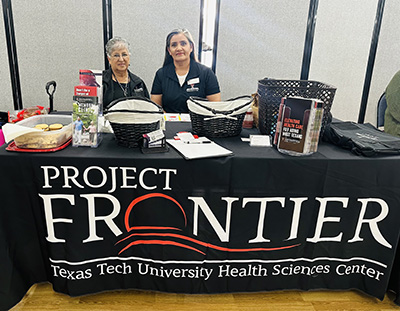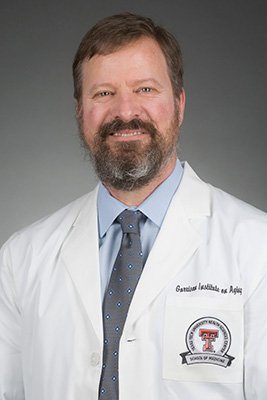Improving Health Care Access, Education Through Research
TTUHSC Seeks to Build Bridge Between Laboratory and Community Needs
The service area for Texas Tech University Health Sciences Center (TTUHSC), a recognized leader in academic health and biomedical research training, encompasses 121 Texas counties. The West Texas portion of this service area is comprised of 107 counties, most of them rural, with about two million residents spread across a land area big enough to be the fifth largest state in the U.S. In fact, 92 counties in Texas each have a population under 10,000 residents, and more than two-thirds of those counties are in TTUHSC’s West Texas service region.
“In our region, health care tends to be clustered in major metropolitan areas,” Lance McMahon, Ph.D., TTUHSC’s chief research officer and executive vice president for research and innovation, said. “We have health disparities that are a great concern for our communities, and as an academic health center, it is our responsibility to help understand and address the health disparities of our region.”
STUDYING THE RURAL GAPS
A handful of studies and statistics have begun to identify health disparities between rural residents and city dwellers. These disparities often are attributed to low health literacy, inadequate access to health care and a general lack of understanding of — and participation in — population health and epidemiological studies which seek to understand risk and protective factors for health outcomes in rural areas. This shortfall in epidemiological studies and other research related to rural disparities leaves critical gaps in understanding health problems and potential interventions for improved health outcomes.
Published studies suggest that risk and protective factors might also differ in rural areas due to additional lifetime stressors and socioeconomic barriers, such as food and financial insecurity. Despite new knowledge highlighting health care hurdles, research into how best to combat them is limited, which perpetuates the challenges and highlights the importance of engaging rural communities in research to align priorities, needs, activities and interventions with those sought by communities.
Limited access to and under-utilization of health care stemming from a shortage of health care providers and specialists (e.g., OB/Gyns, neurologists), combined with insufficient transportation and health insurance, increases the risk for adverse health outcomes for rural residents. There is a need to better understand and reduce challenges for rural communities by enhancing community engagement research capacity and giving voice to those with lived experience and local knowledge. This is especially true with cancer.

Jeff Dennis, Ph.D.
Jeff Dennis, Ph.D., from TTUHSC’s Julia Jones Matthews School of Population and Public Health, is researching the unique demographics (population and geographic) of TTUHSC’s service area and the specific disparities these residents face related to health care services, including those for cancer. He said a significant number of rural residents in TTUHSC’s service area live five hours or more from the nearest National Cancer Institute-Designated Cancer Centers in Dallas, Oklahoma City, Albuquerque, San Antonio or Houston.
“Given the known benefit of social support for cancer care, West Texans having to spend significant time away from family and their broader community for cancer treatment can pose a significant strain on the health and well-being of patients and their families,” Dennis said.
Cancer is the second leading cause of death in Texas. In the West Texas counties covered by TTUHSC, the disease takes the lives of nearly 4,000 individuals every year. Using 10-year age-adjusted mortality rates, Dennis said 87 out of the 121 counties, or approximately 71% in the TTUHSC service region, have mortality rates above the state’s overall cancer mortality rate.
“A significant number of these counties are very rural with limited access to cancer screening,” Dennis pointed out. “They also are geographically distant from other cancer treatment options. The especially small population of these counties poses significant challenges to understanding cancer risks and trends. For example, a specific cancer type may only occur twice in a year on average in a rural county, meaning that four cases in a given year effectively doubles the reported incidence.”
RESEARCH SPARKS ACTION, RURAL PROGRAMS
At TTUHSC, research conducted by dedicated faculty such as Dennis is often referred to as the engine that drives innovation and discovery. To capitalize upon that strength and address some of the health care accessibility issues facing rural residents, TTUHSC has developed several programs and initiatives that serve as a bridge from the research lab to the community.
 Two long-standing institutes at TTUHSC, the F. Marie Hall Institute for Rural and Community Health and the Garrison Institute on Aging, offer numerous programs and initiatives that address rural health challenges, including
data collection to understand barriers that rural communities face and services that
help to mitigate those barriers in medically underserved areas.
Two long-standing institutes at TTUHSC, the F. Marie Hall Institute for Rural and Community Health and the Garrison Institute on Aging, offer numerous programs and initiatives that address rural health challenges, including
data collection to understand barriers that rural communities face and services that
help to mitigate those barriers in medically underserved areas.
For more than 20 years, these institutes have cultivated substantive relationships with Texas rural hospitals and clinics, including the Texas Organization of Community Rural Hospitals (TORCH) and Federally Qualified Health Centers. This includes a large catchment area serving more than three million people living primarily in underserved rural areas. Engagement in these rural areas has included epidemiological studies, educational content, community service programs and clinical care.
Cynthia Jumper, M.D., TTUHSC’s executive vice president of health policy and strategic initiatives, said the TTUHSC Office of Strategic Initiatives is at the forefront of innovation, addressing the health care needs of rural Texas communities whether those needs are required in correctional facilities or rural and community hospitals.
Through a partnership with TORCH, Jumper said TTUHSC provides telehealth services across 17 rural and community hospitals and their associated clinics, supporting emergency departments, clinics and inpatient settings.
“Driven by our mission to enhance health care access in West Texas and beyond, TTUHSC remains committed to expanding our reach,” Jumper said. “By supporting communities and health systems, we are seeking to deliver exceptional, renowned care to those who need it most.”
The F. Marie Hall Institute for Rural and Community Health collaborates with West Texans to advance community health through imaginative and scholarly research, innovative use of technology, comprehensive education and outreach. To accomplish this, Billy U. Philips Jr., Ph.D., TTUHSC’s former executive vice president for rural and community health, said the institute engages in partnerships that lead to better health outcomes.
“Its focus is to improve rural health access and health outcomes through research and demonstration programs that are ‘proof-of-concept’ projects,” Philips said. “Some of these projects have become statewide efforts to bring virtual mental health counseling to more than 400 school districts.”
According to Philips, the F. Marie Hall Institute for Rural and Community Health has published much of its work in the peer-reviewed literature and through Rural Health Quarterly, a quarterly publication indexed on the Rural Health Research Web.
“Rural health care is crucial to the well-being of the people that produce the food, fuel and fiber that are essential to the state’s economy and to worldwide markets,” Philips said. “Ms. Hall was a champion and endowed the F. Marie Hall Institute for Rural and Community Health, a sign of her love for the people of West Texas and beyond.”
To further underscore the university’s deep and growing commitment to rural communities, TTUHSC established the Division of Rural Affairs (Rural Affairs), a bold, coordinated effort to transform the landscape of rural health in Texas and beyond. Bringing together the F. Marie Hall Institute for Rural and Community Health, the Institute for Telehealth and Digital Innovation and a growing portfolio of rural-facing programs, Rural Affairs serves as the university’s central driver for improving access to care and shaping the future of care in underserved regions.
Cole Johnson, J.D., interim executive vice president of Rural Affairs, said the division is an extension of TTUHSC’s mission in motion. Through strategic partnerships, applied research and scalable innovations, the division channels the strength of TTUHSC’s expertise into communities that are vital to the state’s well-being. Johnson said Rural Affairs reflects TTUHSC’s belief that rural health isn’t peripheral — it’s foundational.
“Too often, we wait until symptoms show up before seeking care, but in rural communities, that delay can mean fewer options and worse outcomes,” Johnson said. “We need to take a more proactive approach to our health — make it part of everyday life, not just something we think about when we’re sick. Good health is the foundation that allows rural Texans to thrive — it’s what keeps our families strong, our work steady, and our way of life moving forward.”
PROJECT FRONTIER: A COMPREHENSIVE EFFORT
The Garrison Institute on Aging is the home of Project FRONTIER (Facing Rural Obstacles to Healthcare Now Through Intervention, Education and Research), a longitudinal study that collects epidemiological, neurological and biological data on cognitive health and aging in a multiethnic adult group of volunteers from rural West Texas communities. The project is designed to identify factors which influence aging and disease progression by placing an emphasis on improving diagnosis, treatment and care in rural areas.

Neugebauer, executive director and chief scientific officer for TTUHSC’s Garrison Institute on Aging, said the Project FRONTIER initiative is a vital step toward ensuring that all populations, regardless of location, have access to the resources and knowledge needed for healthier aging.
“Project FRONTIER is very much in line with the mission and vision of the Garrison Institute on Aging to promote healthy aging and address health issues in the aging population,” Neugebauer added.
The Project FRONTIER study has been ongoing for nearly two decades, enrolling more than 1,800 aging rural adults older than 40 years from four rural counties in West Texas, including Cochran (population 2,526), Bailey (population 6,779), Parmer (population 9,869) and Hockley (population 21,161).
Approximately 500 of the 1,800 Project FRONTIER study participants suffer mild cognitive impairment or some form of dementia. There are currently more than 2,000 data points collected from each participant at baseline, and they are recontacted every three years. Project protocol consists of a medical exam, blood draw, interview and cognitive testing. The entire protocol takes approximately three to four hours to complete, and all participants are reimbursed for their time. A feedback letter and a copy of their clinical lab results are mailed to each participant and to their designated health care provider if they have one.
And while the four rural counties in which Project FRONTIER study participants reside are quite large in terms of area, ranging in size from 775-909 square miles, they all lack clinical care providers and are more than an hour from the TTUHSC campus in Lubbock, Texas.
VIBRANT MOMS: COMMUNITY-ENGAGED RESEARCH
Another major area of research focus at TTUHSC is the existence of maternity care deserts. These are counties where no maternity care exists, and in the Texas Panhandle, maternity care deserts are more common than in other regions of the state. In fact, using data on Maternal Care Centers provided by the Texas Collaborative for Healthy Mothers and Babies, Dennis said 76 of the 107 West Texas counties in the TTUHSC service region are maternal health care deserts without a birth center providing obstetric care.
To better understand the maternal health landscape and develop community-driven, community-based solutions to reduce maternal morbidity, a team of TTUHSC researchers is leading a coalition of 30 community organizations across six Texas Panhandle counties.
 This project, called VIBRANT MOMS (Verifying and Implementing Evidence-Based Programs Addressing Needed Transformations
for Maternal Health Outcomes, Measures and Support), is a two-year, phase I project
funded for $1.37 million by the NIH’s IMRPOVE-CIP (Implementing a Maternal health
and PRegnancy Outcomes Vision for Everyone initiative as a Community Implementation
Program). IMRPOVE-CIP is a program under the NIH’s Community Engagement Alliance,
which focuses on partnerships with community organizations to carry out research to
improve community health.
This project, called VIBRANT MOMS (Verifying and Implementing Evidence-Based Programs Addressing Needed Transformations
for Maternal Health Outcomes, Measures and Support), is a two-year, phase I project
funded for $1.37 million by the NIH’s IMRPOVE-CIP (Implementing a Maternal health
and PRegnancy Outcomes Vision for Everyone initiative as a Community Implementation
Program). IMRPOVE-CIP is a program under the NIH’s Community Engagement Alliance,
which focuses on partnerships with community organizations to carry out research to
improve community health.
This effort is led by Christine Garner, Ph.D., assistant vice president for research who also serves as an assistant professor in the Department of Obstetrics and Gynecology and as a member of the InfantRisk Center at the TTUHSC School of Medicine; Julie St. John, Dr.P.H., Texas Community Health Worker Instructor and an associate professor in the Office of Research and Innovation of TTUHSC School of Health Professions; and Stephanie Stroever, Ph.D., assistant professor in the School of Medicine Department of Medical Education and director of research, Department of Emergency Medicine. Community leads on the project are Casie Stoughton, R.N., director of Amarillo Public Health District and Cindi Wynia, director of the Safe Kids program.
Garner said the VIBRANT MOMS project uses community-engaged research approaches and community-based participatory research to involve local community members in the research process, including those who may benefit from the project.
“Community members have guided data collection by identifying what questions needed to be asked,” Garner said. “They have received training for research methods and actively collected data. They also regularly provide insights about findings from the phase I study as they emerge. A core team of community and academic leaders meet monthly to ensure frequent engagement and community-centered strategies, and the full coalition meets quarterly to present data, receive feedback and make major decisions that guide the project.”
Garner said results from the phase I study are being used to develop a phase II implementation trial, which will implement evidence-based interventions through community organizations to reach the community members who may benefit from them.
“During phase I, the community-based coalition identified preeclampsia as the maternal health concern to address in phase II and identified preeclampsia risk factor screening and prophylactic low-dose aspirin as the evidence-based interventions to be implemented,” Garner explained.
In phase II, Garner said implementation science strategies will be carried out across 13 community organizations in both community and clinical settings with community health workers positioned as the key implementation team members.
The VIBRANT MOMS team meets regularly with other NIH-funded community research coalitions to exchange ideas and develop solutions which facilitate improved community engagement in research, build trust in science, improve health knowledge by working with trusted messengers within communities and address needs that are important to community members.
“These collaborations elevate TTUHSC’s methods and strategies to the most current and cutting-edge approaches in community engagement research,” Garner stressed. “They also highlight West Texas communities on a national stage, bringing attention to our region and university for the important work being done locally to improve maternal health, which is critical given our nation has the highest maternal mortality rate of any developed nation.”
EXPANDING CLINICAL, COMMUNITY-BASED RESEARCH
TTUHSC’s effort to build a bridge between the research it conducts and the health care services that a community lacks also will benefit from a three-year, $1.16 million NIH grant awarded to a project team led by McMahon to conduct a capacity-building study. The grant is one of the first at TTUHSC that was made possible when the university was officially designated as a Hispanic-Serving Institution in 2022 by the U.S. Department of Education.

Lance McMahon, Ph.D.
“This is what is called a cooperative agreement,” McMahon said. “We are going to interact with program staff at the NIH; these are the people who help establish the research priorities of the different NIH institutes. They're plugged in, so they can give us feedback, and we can help describe to them who we are, what we do and what our strengths and weaknesses are.”
Broadly defined, the grant is for building research capacity. TTUHSC has been well known for basic and translational laboratory research. McMahon said the university is committed to ensuring continued success in the basic and preclinical sciences, and will leverage this strong basic science foundation to create a vision that is committed to developing, expanding and strengthening clinical and community-based research.
The project will begin with a needs assessment that will incorporate preliminary data and optimize the tools and instruments required to gather new information. McMahon said the project team will use risk assessments, SWOT (Strengths, Weaknesses, Opportunities, Threats) analyses and evidence-based tools developed in research studies and by leading organizations such as the National Council for University Research Administrators. The needs assessment also will include interacting with the university community, then using that community input to help define the research needs and identify solutions.
“To ensure basic biomedical research discoveries are effectively translated into patients and communities, the NIH appears to be funding more implementation and community-based research projects,” McMahon suggested. “These types of research projects directly engage the individuals who expect that investment of tax dollars will yield improved health outcomes. TTUHSC is perfectly positioned to ensure there is mutual benefit between the rural communities of West Texas and agencies committed to funding this type of research.”
To achieve those goals, McMahon said TTUHSC is working to develop a Community Engagement Core to increase community-engaged research capacity to reduce disparities in West Texas rural communities.
“We are aiming to significantly improve low health literacy, high rates of isolation and the lack of access to health care in many of the rural areas we serve,” McMahon said. “This grant will help us do that by enhancing people’s understanding of research and increasing their participation in clinical trials related to that research.”
Related Stories
TTUHSC Cancer Researcher Honored by National Academy of Inventors
C. Patrick Reynolds, M.D., Ph.D., director of the School of Medicine Pediatric Cancer Research Center at TTUHSC, has dedicated his life as a researcher to developing treatments for childhood cancers.
TTUHSC’s Hudson Set to Serve as President for Society of Clinical Research Associates
The Society of Clinical Research Associates (SOCRA) has elected Texas Tech University Health Sciences Center’s (TTUHSC) Catherine Hudson, Dr.P.H., as its president for 2025-2026.
Clinical Research Institute a Source of Pride for Retiring Griswold
Upon his retirement, John Griswold, M.D., reflects on the Clinical Research Institute and what it has achieved.
Recent Stories
TTUHSC Cancer Researcher Honored by National Academy of Inventors
C. Patrick Reynolds, M.D., Ph.D., director of the School of Medicine Pediatric Cancer Research Center at TTUHSC, has dedicated his life as a researcher to developing treatments for childhood cancers.
TTUHSC School of Nursing Celebrates 10 Years of the Veteran to BSN Program
The TTUHSC School of Nursing recognized the 10-year anniversary of the Veteran to Bachelor of Science in Nursing (VBSN) program during the fall 2025 commencement ceremonies held Dec. 13 in Lubbock, Texas.
TTUHSC Dean to be Inducted into the National Academies of Practice as Distinguished Fellow
Gerard E. Carrino, Ph.D., MPH, dean of the TTUHSC Julia Jones Matthews School of Population and Public Health, will be inducted into the National Academies of Practice (NAP) as a Distinguished Fellow of the Public Health Academy.
